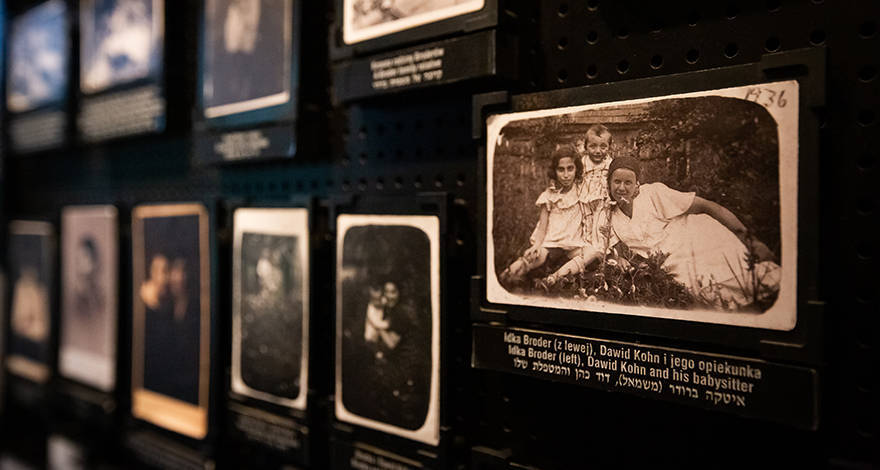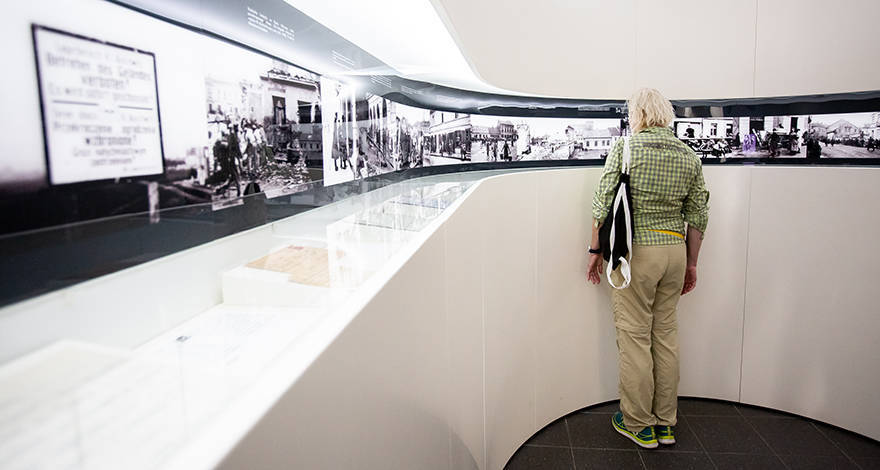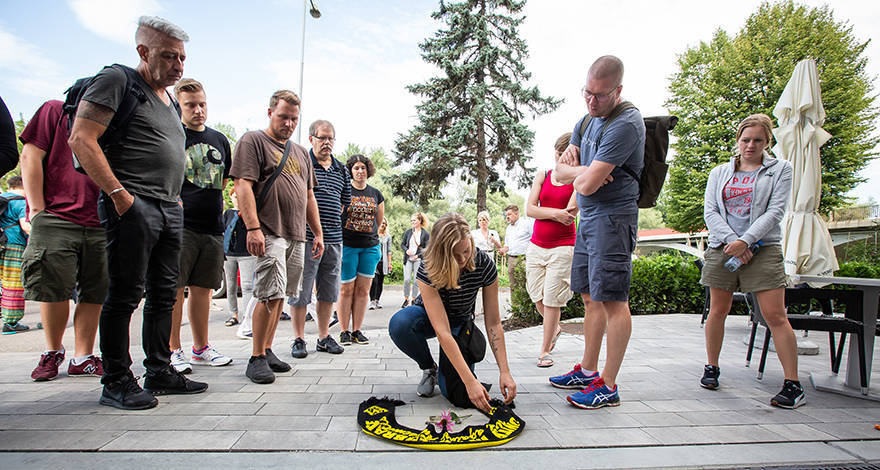Bundesliga club Borussia Dortmund have invested a lot of energy and introduced a remarkable initiative as part of their efforts to combat right-wing extremism and antisemitism.
25/08/2019
Bundesliga club Borussia Dortmund have invested a lot of energy and introduced a remarkable initiative as part of their efforts to combat right-wing extremism and antisemitism.
Auschwitz – Bundesliga outfit Borussia Dortmund are one of the clubs in Germany that right-wing extremists like to target as a platform for their message. The Dortmund district of Dorstfeld is known for being one of the biggest hotspots in Germany for Neo-Nazis, whose influence extends to the famous south stand. Since 2013, the club have been attempting to combat this trend by investing a lot of energy and introducing a remarkable initiative, an element of which is fans taking regular educational visits to Auschwitz, the former extermination camp.
As she stands in barrack block 5, where black and white photos of the infamous ramp are displayed, Martina cannot hold back her tears any longer. They are images that depict the full horrors of the selection process. Those people in the grainy pictures that were sent to the left would later meet their end in the gas chambers or incinerators; those that were sent in the opposite direction by their SS guards were exploited as cheap labour and subjected to unspeakable suffering. Many of them would die further down the line.
The 55-year-old, whose positive outlook on life usually manifests itself in regular bouts of laughter, is now in tears. She’s surrounded by others who are struggling to keep their composure. “In that moment, you can’t help it,” a red-eyed Martina explains later on. It’s not just an isolated moment either; there are many others that the Hiltruper native and her fellow visitors experience throughout their time in Auschwitz, a place where up to 4,000 people were killed every day between 1940 and January 1945. Scarcely believably, 1.1 million people lost their lives.
BVB brushed the problems under the carpet for too long
This is the ninth time a fan visit to Oswiecim – as the town in the south of Poland is known to the locals – has been organised by Borussia Dortmund. The 33-year-old Daniel Lörcher has been present from the start, having helped to launch the initiative. He first came to Oswiecim with several Dortmund ultras on a trip they had organised themselves in 2011. “We noticed that we were too unprepared to deal with it all,” Lörcher explains.
The Dortmund native used to be a capo for “The Unity”, the largest ultra group in the south stand, one of the young men who encourages thousands of fellow fans to get involved in chants and choreographies. Lörcher has been working at BVB since 2013, working in various roles – including as a fan representative – before recently joining the “Corporate Responsibility” department at the club. When you speak to him about the educational work BVB do, his passion is evident from his hand gestures alone. You can sense he’s a man on a mission. As is the historian Andreas Kahrs, with whom Lörcher has been working on the project since 2011. BVB’s main sponsor Evonik have been behind them the whole way. There is, for example, an educational trip organised for employees of Evonik and BVB. Evonik’s predecessor company, Degussa, was complicit in some of the Third Reich’s crimes.
It shows that the Black & Yellows, who spent many years trying to sweep the problem of right-wing influences within the fan scene under the carpet, have now taken a clear stance and have been trying to combat the issue with appropriate educational work for almost 10 years. The trip to Auschwitz costs every participant €50. The remaining costs for flights, accommodation and lodgings are covered by the club. “Without us applying for any kind of grants,” explains Lörcher.
“The internal impact is remarkable”
To date, the mission has largely made an impact behind closed doors rather than in full public view. “First and foremost, we want to reach the fans,” said Lörcher, adding that “the internal impact has been remarkable to date”. This is the first year a journalist has been allowed to come, following much consideration among officials and the granting of the group’s permission.
At the outset, it proves to be a rather arduous liaison as mistrust first needs to be broken down. Because many moments during this trip are shaped by emotion and intimacy. Among the younger participants, who take their fandom extremely seriously, there is a lot of skepticism about granting the public access. The group is very diverse, with young and old, men and women, fans from the south and main stands.
Back in the main camp Auschwitz, Marie is completely bowled over by all the hair she sees piled up in a display cabinet. All it is is hair – usually light as a feather. But what she’s looking at in a glass display case in block 5 are seven tonnes of it, sitting there as evidence of a repugnant disregard for humankind and the last visible reminder of countless lost lives. She briefly considers how many people met their deaths to make this unfathomable mound of hair. But she is quickly prevented by the absurdity of the calculation. She cries. Fellow visitor Alexander is moved, too. She is sitting outside under a birch tree, near a watchtower and two layers of barbed wire. She sits there for minutes in silence, before saying: “You feel as though you’ve been smashed on the head by a hammer.”
BVB chief executive Watzke joins in 2017
Hans-Joachim Watzke joined the visit to Auschwitz in 2017. There’s a rather remarkable photo of the BVB chief executive showing him standing, back to the camera, in front of a pile of empty “Zyklon B” canisters. Canisters that have been opened as if with a tin opener. Canisters that contained the poison that the Nazis used to murder the Jews of Auschwitz. It took around about 20 minutes for the hydrogen cyanide, which was actually produced to combat pesticides, to condemn the people in the gas chambers to a most gruesome murder. They choked to death.
While it’s impossible to tell from the photo what’s going through Watzke’s mind, he certainly looks visibly shaken. The picture has become one of the most distinctive in a book about the club’s educational work which BVB dedicated to the Yad Vashem holocaust memorial as a gift. In the book, Watzke is cited as saying: “It fills me with a special sense of pride that such a fan initiative with many activities to combat discrimination exists, that staff members from various different departments have been and are being trained and that our partners and sponsors stand by our side as we continue to work on these issues.”
It’s a long sentence. But the core message is that BVB have taken a clear stance against right-wing extremism, antisemitism and any form of discrimination.
Surreal feeling in the main camp
There’s a surreal feeling outside at the main camp at Auschwitz. The sun is shining, the grass between the 28 camp buildings is green and birds are singing. None of it seems to fit with such an atrocious past. Until Ewa Pasterka, the guide who accompanies the group across the six hectares of the main camp, explains that the longest emergency roll call that ever took place there lasted 19 hours. In the height of summer in 1940. In temperatures of over 30 degrees. At least one prisoner died.
Ewa, a strong-willed elderly lady, asks the participants why they can’t speak any Polish. “We’re neighbours after all!” When somebody quips that it’s such a hard language to learn, she responds: “German’s not easy either. Just look at the word ‘Reichssicherheitshauptamt’.” The Reich’s Main Security Office, or the RSHA for short, was the central authority of the SS. In department IV B 4 of the RSHA, SS Obersturmbannführer Adolf Eichmann organised the bureaucratic side of the “Final Solution to the Jewish Question”.
A week in Oswiecim
The study visit to Oswiecim lasts a week. It’s a long time, during the course of which the participants are repeatedly confronted with unimaginable atrocities. But they quickly notice that they can overcome their fears and sadness within the group. A major source of help in this respect are Amelie Gorden, who works in the same department as Lörcher, and the BVB fan representative Antje Boedecker, who both accompany the travelling party in a pedagogical capacity.
In addition to methodically preparing the group situations, they believe it is of essential importance to respond to the needs of the individuals and the group as a whole and, along with Lörcher and Kahrs, to be available for any questions or requests that may arise. “We spend a week here conducting a program that is of a very high level,” said Andreas Kahrs, adding: “You don’t just come here and have a week of fun.”
“That said, the fun is part of it all and helps to process everything,” added the 38-year-old historian, who has consciously set the bar high. “Our tactic is not: Let’s not make it overly complicated, they are football fans. Rather, the opposite is true.” That said, the trip is interspersed with plenty of breathers for the group. Moreover, each person has the opportunity to take themselves away at any point. In addition to the visits to the camp in Auschwitz and the neighbouring camp Buna-Monowitz, there are detailed preparations/follow-ups, workshops and group discussions about what has been seen.
A day later, the group sets out on a trip to Auschwitz-Birkenau, the infamous sister camp where arguably the worst atrocities in the history of humankind were committed. It’s a place in which the death machinery deployed by the Nazis reached a cynical efficiency. Opposite the old ramp at Birkenau, where two transporter wagons form a small memorial, sits a family home. The owners have put up a whole host of cheerful decorations and toys in the garden. The wind chimes and fake fountains almost appear to be a statement of rebellion against the horrors that took place on the other side of the street, less than 15 metres away. A mountain of kitsch, seemingly out of place. The BVB fans commemorate the victims by placing a scarf and flowers on the wagons. They then pause for several minutes. As they depart, Kay looks over at the house and says: “How can you live here?”
“How can you live here?”
It is the first time that people who can hear have been accompanied on the trip by the hard of hearing. It creates an additional exciting dimension. The Deaf Fan Club at BVB has more than 150 members, some of whom have joined the trip to Oswiecim. To ensure they quickly feel included, they are accompanied by two sign-language interpreters. At the same time, the group members have been learning some signs on a daily basis. When Florian Hansing, the Chairman of the Deaf Fan Club, sees Marie, who can hear normally, and the hard-of-hearing Susanne sitting on a bench together, the 28-year-old, who also works full-time as a social worker at BVB-Projekt Dortmund e.V., smiles and says: “They’re sitting there without an interpreter, that shows the goal’s already been achieved.” The ties are strengthened even further in the workshops and discussions. The hard-of-hearing, who have their own block with 28 spaces in the Dortmund stadium, have broken down the barriers here in Auschwitz and become a natural part of the group.
From the old ramp in Birkenau the group head to the main camp, which overwhelms most people with its sheer size. “It’s inconceivable. You get an entirely different impression,” says Christian, who lives near Offenbach. Most of the visitors bustle about in the imposing entrance area with the long ramp along the train platforms. Many of them are tourists who have made the journey of 70 kilometres from Krakow across to Birkenau. You can sense that many of these people have not prepared themselves well for this visit. A young man is wearing a t-shirt with a skull on it. Some of them are posing for selfies in front of the platforms. The Dortmund group shake their heads. The BVB fans head further into the camp than almost any other visitor, until they reach the place where countless corpses were incinerated and then buried in mass graves in order to leave no trace. Until eventually the gruesome work was taken on by the ovens of the Erfurt-based company “Topf and Sons”.
Like every other evening, the participants meet afterwards to talk through their experience. They place their trust in the group and let it pick them up. Their shared experience forms a strong bond between the participants, which in many cases will continue even once the trip is over. Previous excursions have proven this to be the case. At the same time, they are multipliers who pass on their experiences. Daniel Lörcher says: “This is a way of meeting for people who wouldn’t necessarily come across each other at the stadium, because one is in the south and the other in the main stand. It’s a way for different fan cultures to connect and get to know each other. The results are some very, very exciting connections between people who engage in thought together – and not just about football.”
Author: Jens Greinke, Westfälischer Anzeiger
Photos: Anna-Lina Nikelowski







